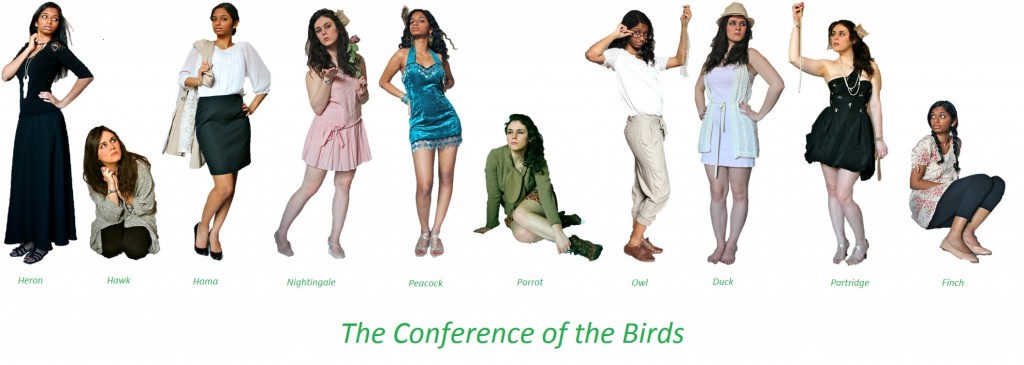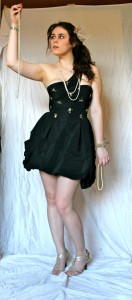30th
April
2012
Qawwali_Dance
The qawwali is a Sufi musical form common in South Asia which praises God. According to Carl W. Ernst in The Shambhala Guide to Sufism, music and particularly the human voice are used to bring out powerful emotions in praise of God in the Sufi tradition (180). The qawwali is known to have brought listeners into ecstasy, such as Qutb al-Din Bakhtiyar Kaki, who was in ecstasy for three days and died when the singer stopped mid-verse (186-187). It is apparent that qawwali is a musical form which can inspire emotional ecstasy in the devout who listen to it.
We chose to choreograph a short dance to this clip from the qawwali “Allah Hoo” by Nusrat Fateh Ali Khan. This song has a lively beat which was enjoyable to listen to and inspired dancing. Ernst describes Nusrat Fateh Ali Khan as “a Pakistani singer trained in Chisti qawwali ritual” who “records in the world music genre and collaborates with American musicians on movie sound tracks” (180). He notes that qawwali is a form of music which became popular internationally because of its enjoyable rhythm, even among audiences who cannot understand the words. The line used in this clip, “jab na thaa kuch yahaan, thaa magar tuu hi tuu,” translates to “at that time there was nothing except you.” This refers to a time before the world existed and there was only God, so the song is about total and utter devotion to God. For me personally, the repetitive nature of the lyrics for this portion of the song (repetition of “Allah Hoo”) helped me to really experience it as a chant of praise, even before looking up the lyrics.
In our dance, we attempted to convey the spirit of the song through our South Asian choreography. We begin by bringing our hands up to the sky and back down to the ground to represent the relationship between humans on Earth and Allah in the heavens. We spin with our scarves in a fashion similar to that of the “whirling dervishes” who lose themselves in ecstatic prayer while listening to music. We raise our arms with simple and elegant wrist motions to demonstrate a call to Allah to grant us his beautiful presence. We took advantage of the rhythm to do very enthusiastic steps, demonstrating how the music filled us with energy. Towards the end, the three of us spin together to demonstrate the way Muslims around the world come together in praise of Allah. We appreciated that we could take a Western approach to interpreting the song and still capture an important aspect of qawwali as a form of prayer, which is the energy of the rhythm. Through this dance, we attempted to demonstrate a close connection to the music and an understanding of its meaning as a loving and ecstatic communication with God.
Link to complete song: http://nusrat.info/allah-hoo-allah-hoo/
posted in Uncategorized |
29th
April
2012

I was inspired by The Conference of the Birds by Farid ud-Din Attar to design a fashion photo shoot. Each photograph represents one of the birds who gives an excuse to the hoopoe for why not to look for their potential king, the Simorgh. Fashion is an excellent medium to represent each bird because it’s about image and influencing others’ perceptions by putting up a front. Similarly, each bird in the story behaves one-dimensionally in an attempt to convince the hoopoe that their identity excuses them from the journey. Each of these birds personifies a single fault of every human, so we used the same two models to represent multiple birds. I combined each of the individual photographs to create one larger image, representing how these multiple facets of a personality overlap and interact with one another in a single person.
We designed outfits and poses to fit the personality of each bird. The heron in all black looks longingly towards the others, as the miserable heron in the poem loves the sea where “no one hears [her] desolate, thin cry” (47). The hawk boasts of “grand connections in the sky” (45), staying close to the center of power, crouching in grey clothing with little personality of her own but gazing up at the influential homa. The vain homa claims to “soar and fly on lofty aspiration’s lordly wings” (43), so she wears a suit skirt and a trench coat to represent her hunger for power in business. The nightingale is infatuated with a rose, saying, “her buds are mine; she blossoms in my sight – how could I leave her for a single night?” (36). She wears pink, holding a rose and demonstrating her delusional love with a kiss. The proud peacock in his many-colored splendor describes how he “was once a bird in paradise” (39), wearing a bright blue showy dress and jewelry to show off. The parrot is colored “the earth’s variegated green” and searches for “the stream of immortality” (38). Thus, the parrot is dressed in earthy tones and is on the ground but looks off into the distance, thirsting for immortality. The miserly owl searches for hidden treasure among ruins, saying, “love is solely for gold’s buried glory” (48). The owl is in simple tones but remanis fixated on a gold chain. The self-righteous duck believes he is “the purest bird that ever flew or swam” (40), wearing all white and standing haughtily. The partridge says his “one desire is for jewels” (42) so she is covered in jewels and gazes at a string of pearls. The timid finch says she is “less sturdy than a hair” (49) so she sits in the corner, dressed in pink and looking childish to represent weakness and immaturity. I chose not to create an outfit for the hoopoe because the hoopoe has great depth of character that the other birds lack while they make their excuses, and thus can’t be easily represented by just a few clothes.
The high resolution original photographs can be viewed by clicking the images below.





posted in Uncategorized |
29th
April
2012

I chose to make a promotional poster for Feminist Coming Out Day featuring Marji, the main character of Marjane Satrapi’s autobiographical graphic novel, Persepolis. I feel that this poster is an appropriate representation of Marji because she is a strong female character who inspires other young women to think for themselves. For me, reading Persepolis was a meaningful experience because I saw the film several years ago, when I was about Marji’s age at the end of the novel. Marji was a role model for me as someone who isn’t afraid to stand up for what she believes in and is unapologetic about her opinions.
Marji embodies the phenomenon of third wave feminism, which avoids any singular definition of femininity. Third wave feminism recognizes that no two female experiences are the same and in particular acknowledges that cross cultural differences exist in women’s lives and values. Marji’s story is one of a young girl in Iran struggling to find her identity along with many other women who battle for their own freedom, without attempting to conform to any particular Western definitions of liberty. Marji is empowering because she fights for her ideas about freedom and right and wrong. For example, she wears nail polish and refuses to take it off, even when her parents warn her that she may get arrested (119). When the veil becomes mandatory, she goes with her mother to protest it and pass out flyers because she did not believe the veil should be required (76). She enjoys Iron Maiden, Kim Wilde, and Michael Jackson, and she openly wears “punk” sneakers, denim jackets, and tight jeans, even though these tastes are not consistent with the values of the revolution (131-133). This portrayal of her and similar portrayals of the women around her break down the stereotypical image of women in Iran as victims of oppression during the revolution. Instead, they were highly active in asserting their beliefs and defining their own identities. Thus, Marji and the women in her life are exactly what feminists look like.
posted in Uncategorized |






